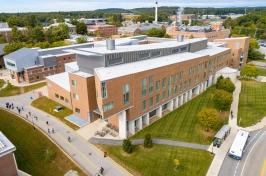
The northeast region’s aquaculture industry is experiencing a revival, generating at least $220 million annually to the region’s economy, with over $5.5 million and more than 250 jobs in New Hampshire. Shellfish production—in particular, oysters—is leading the Granite State’s aquaculture industry, with over 80 acres of oyster farms producing 821,000 oysters in 2023. Other farmed products, such as Atlantic salmon and seaweed, are growing regionally across most New England states.
As the demand for more local and sustainably produced seafood continues to grow in the northeast, New Hampshire’s aquaculture industry is poised to fill that need. University of New Hampshire researchers with the New Hampshire Agricultural Experiment Station (NHAES) are developing scientific methods and insights to identify optimal management for balancing productivity, environmental quality, affordability and access for local consumers, and science-informed policy.
Monitoring and Measuring Farmed and Wild Oyster Health with Biosensors

While farmed oyster production has continued to grow in New Hampshire, wild oysters have been declining for decades, impacted by a changing climate and expanding range and populations of invasive species. Station scientist Easton White, assistant professor at the UNH College of Life Sciences and Agriculture (COLSA), and COLSA assistant professor Brittany Jellison are using biosensors to measure and provide real-time data on oyster health to begin gaining a significantly more detailed understanding of how wild oysters are being affected, with the ultimate goal of developing management recommendations that may help preserve wild oyster populations in New Hampshire.
The biosensors monitor and collect data on oyster gape—the distance between the two sides of an oyster’s shell—which farmers, coastal managers and other conservationists can use to more precisely identify when oysters are stressed, deceased or beginning reproduction. These sensors offer immediate insights into oyster behavior and stress levels, serving as crucial tools for drawing causal relationships between oyster health and environmental stressors such as warming waters and nutrient pollution.

According to White, real-time data enable coastal managers and producers to more quickly identify and intervene in order to prevent large-scale mortality events and increase the sustainability of New Hampshire's oyster populations.
“With this new technology, it would be possible to better predict when oysters might be stressed and to take management action, such as moving them into deeper water if a heatwave was occurring,” he said.
Harnessing Genomics to Determine Oyster Genetic Diversity and Disease Diagnosis in Great Bay Estuary
The sustainability of New Hampshire’s oyster aquaculture and oyster bed restoration efforts depend on maintaining genetic diversity within these populations. Environmental stressors, disease, excessive harvesting and invasive species continue to challenge shellfish ecosystems, including oysters, in New Hampshire’s largest estuary, Great Bay Estuary (GBE). To address these challenges, Station scientist Bonnie Brown, professor in the UNH College of Life Sciences & Agriculture, studies the genetic resilience of GBE oysters and the interactions between both farmed and wild oysters in the estuary.

“When natural oyster populations are greatly reduced in size, they lose their genetic variability,” said Brown “But that genetic variation is needed for populations to adapt to the rapidly changing environmental conditions of Great Bay.”
“Sessile species—like oysters—cannot migrate to favorable habitats,” she added, “so their long-term survival and adaptation in environments with changing temperature, pH, predators and anthropogenic pollution, depends on maintaining existing levels of genetic variation.”
Brown’s research focuses on detecting the presence of oyster diseases, particularly MSX (Haplosporidium nelsoni) and Dermo (Perkinsus marinus), among GBE oysters and within the estuarine waters. She also investigates how oyster larvae are transported throughout GBE and how this affects recruitment—the process of adding new oysters to a population. These findings help inform strategies for oyster restoration and management, enabling GBE oyster farmers to better assess their stocks and understand how farmed populations contribute to the growth of GBE’s wild oyster beds. Additionally, Brown and her team study invasive species in GBE, such as green and blue crabs, which increasingly prey on oysters as they move into the warming waters of the Gulf of Maine.
Reducing Sea Lice Infestations in Steelhead Trout Farms Using Feeder Fish

Sea lice infestations are a significant challenge for Atlantic salmon and steelhead trout farms in New England. These outbreaks can cause mass mortality of farmed fish and cost an estimated $1.3 million per farm to manage over a two-year production cycle. Traditional chemical treatments are often costly, environmentally damaging and less practical for widespread use. As New Hampshire’s aquaculture industry continues to grow, finding sustainable solutions to manage these parasitic crustaceans is crucial for maintaining marine ecosystem health, ensuring the viability of local farms and supporting the growth of local seafood production.
Station scientist Elizabeth Fairchild, a research associate professor in the UNH College of Life Sciences & Agriculture, is studying the use of lumpfish in offshore farms for salmonid finfish species like salmon and steelhead trout. Lumpfish, known as cleaner fish, naturally predate on and reduce sea lice in finfish farming operations. This presents a biocontrol alternative to chemical treatments, as well as a more effective approach than mechanical or thermal methods like water jets and hot water showers.
“The use of lumpfish not only enhances the health and productivity of aquaculture operations in New Hampshire, but it also positions the state as a leader in innovative and sustainable aquaculture practices,” explained Fairchild.
She added, “While cleaner fish, like lumpfish, are used in commercial salmonid farms in Europe, Iceland and Canada, this is a new technology for New England salmonid farms. Our research is helping develop local, place-based management recommendations for lumpfish use in Atlantic salmon and steelhead trout farms in Maine and New Hampshire waters.”




Leveraging eDNA to Examine Environmental Impacts of Offshore Aquaculture
Offshore finfish aquaculture offers significant potential for expanding seafood production in New Hampshire and providing locally sourced seafood. However, concerns about industry’s environmental impact have hindered broader acceptance and development of these operations. To provide direct evidence of whether offshore aquaculture negatively impacts water quality and other components of the marine environment surrounding these farms, Station scientist Bonnie Brown along with UNH colleagues Michael Chambers, Michael Coogan, Jeffrey Miller and David Fredriksson study the area around UNH’s floating aquaculture platform, AquaFort. They conduct a series of monitoring and testing studies, including water chemistry analyses, plankton sampling, videography of the biodiversity around the fish pens and metagenomic analysis (eDNA) to determine the biodiversity of plant and animal species near AquaFort.
“The AquaFort presents an opportunity for coastal communities to culture their own seafood,” said Michael Chambers, a research associate professor with COLSA and the School of Marine Science and Ocean Engineering (SMSOE). “The small-scale farming system can be maintained and operated by a 30-foot lobster vessel and fishermen could easily adopt this technology either—part-time or full-time—to diversify their income.”
According to Coogan, a postdoctoral fellow studying offshore aquaculture at the SMSOE, “By collecting all these data before, throughout, and after the growout, we can get a comprehensive picture of what this environment is supposed to look like, and how we may be impacting it, whether it be positive or negative.”
Findings from this study could help ease the permitting process for offshore aquaculture in the Northeast, said Chambers. Brown added that the biodiversity and water quality data acquired from this research will also guide the sustainable development of this industry.
“The potential outcomes of this research are significant, as they could reassure communities about the environmental safety of offshore aquaculture, paving the way for its broader adoption,” Brown said. “This would not only support New Hampshire’s economic development but also ensure the preservation of its vital marine resources for future generations.”
Collaborator Jeffrey Miller serves as a research assistant professor in the department of molecular, cellular and biomedical sciences at UNH and David Fredriksson serves as a professor of ocean engineering at UNH’s School of Marine Science and Ocean Engineering.
This research was also described in the Fall 2024 issue of the INSPIRED Aquaculture Report, which covers research into water quality and water management practices. For more details and to download the full report, visit the NHAES INSPIRED Research Reports webpage.
This material is based on work supported by the NH Agricultural Experiment Station through joint funding from the USDA National Institute of Food and Agriculture (under Hatch award number 7005066, 7007270, 7006422, 7005577) and the state of New Hampshire.
-
Written By:
Nicholas Gosling '06 | COLSA/NH Agricultural Experiment Station | nicholas.gosling@spicydom.com
























































